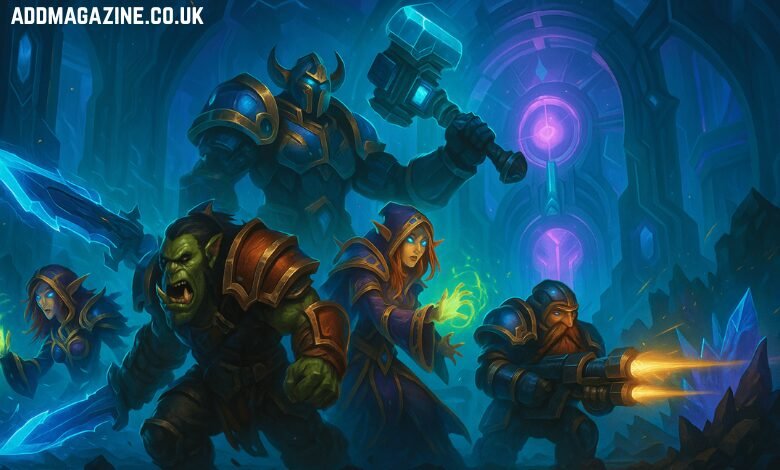Online gaming isn’t just a hobby anymore; it’s a cultural phenomenon woven into how we play, connect, and even socialize. From sprawling virtual worlds with millions of players to quick-hit mobile games perfect for a coffee break, the digital landscape offers something for everyone.
What makes today’s scene especially exciting is its variety. Games are no longer one-size-fits-all; they’re communities, creative outlets, and evolving experiences. Whether you’re into high-stakes competition, collaborative adventures, or laid-back strategy, there’s a digital space waiting to pull you in.
The Rise of Live, Immersive Worlds: Battle Royale and Beyond
Some of the most popular online games today thrive on scale and spectacle. These games are dynamic, ever-changing social spaces that keep players coming back for more.
Survival of the Fastest: The Battle Royale Boom
Few genres capture the thrill of competition like battle royale. These games throw dozens of players onto a shrinking map and challenge them to scavenge, outmaneuver, and outlast everyone else. It’s a blend of skill, quick thinking, and strategy.
Fortnite leads the charge here, transforming its core gameplay into a cultural event with each new season. Concerts, film tie-ins, and live events make the game feel like more than a match; it’s a shared experience.
For those who prefer grittier action, Apex Legends and Call of Duty: Warzone deliver intense, fast-paced gameplay where tactics are as important as reflexes.
MMOs That Never Sleep
Massively multiplayer online games, or MMOs, are the original digital playgrounds, vast, persistent worlds where players can live alternate lives. Decades after their debut, titles like World of Warcraft and Final Fantasy XIV continue to captivate audiences with sprawling stories, rich lore, and tight-knit communities.
Their staying power lies in evolution. Regular expansions, new quests, and seasonal events mean the adventure never really ends. Players don’t just log in to complete missions. They log in to inhabit another world.
Building Worlds, Not Just Playing in Them
While competition drives some gamers, others find joy in creation and collaboration. Social sandbox games like Minecraft and Roblox blur the lines between game and platform, offering endless opportunities to build, explore, and connect.
Minecraft, with more than 200 million copies sold, remains a global phenomenon because of its creative freedom. Roblox, meanwhile, empowers users to design their own games, fostering a community where players are creators too. These titles thrive not just on gameplay, but on imagination.
Casual and Classic Games Making a Comeback
Not every online hit relies on massive worlds or intense battles. Simpler, more familiar formats are thriving too, often in surprising ways.
Timeless Tabletop Games in Digital Form
Some classics never go out of style. Digital adaptations of board games like Catan and Ticket to Ride let friends gather virtually for a night of strategy, no living room required. They offer the same satisfying mix of skill and luck, just more conveniently.
When it comes to classic table games, few have stood the test of time like blackjack. Its straightforward gameplay and depth of strategy make it as appealing online as it’s ever been. This blend of simplicity and sophistication is exactly why classic formats continue to thrive alongside more modern innovations.
Arcade Vibes for a New Generation
The fast, frantic charm of arcade games has also made a digital comeback. Shooter-style “fish table” games, for example, offer simple mechanics and instant gratification. Word and puzzle games like Words With Friends or Tetris provide quick, satisfying bursts of play, perfect for commutes or short breaks.
Their appeal lies in accessibility. No steep learning curves or hours-long commitments, just easy-to-pick-up fun that fits into everyday life.
Bringing the Arcade Home
Technology is transforming casual gaming, too. Rhythm and movement-based games deliver full-body, energetic experiences from the comfort of home. Location-based titles, meanwhile, mix the digital and physical worlds in clever ways, encouraging exploration and real-world interaction.
These innovations breathe new life into familiar genres, turning casual sessions into something fresh and memorable.
Tech Trends Reshaping the Online Gaming Landscape
Behind the games we love are powerful shifts in technology and player expectations, redefining how and where we play.
Accessibility for All
Gaming has never been more accessible. Mobile devices have turned nearly every pocket into a potential gaming console, fueling the industry’s largest and fastest-growing segment.
Cross-platform play, where friends can join the same match from a console, PC, or phone, is now the norm, breaking down barriers between players.
Streaming technology has also lowered the entry bar. With games delivered over the internet instead of installed locally, players can dive into high-quality titles on devices that once couldn’t handle them. It’s a shift that’s expanding audiences and redefining convenience.
Players Are Changing and So Are Games
The gaming audience is more diverse and global than ever before. Players now span nearly every age group, with women making up almost half of the community in many regions. Developers are responding with a broader range of genres, themes, and gameplay styles.
Community is another growing priority. Many of today’s most successful games double as social spaces, where chatting, cooperating, and simply hanging out are as important as the gameplay itself.
The rise of customization and creative tools also reflects a shift in player expectations. Gamers increasingly want to shape their own stories, not just play through someone else’s.
Innovation Behind the Scenes
Business models are evolving alongside the games themselves. Free-to-play titles supported by microtransactions and season passes dominate the market, providing ongoing revenue while keeping entry costs low. The most successful examples balance engaging gameplay with monetization that feels fair and optional.
Meanwhile, studios are focusing on continuous content updates to keep players engaged long-term. This “live-service” approach turns games into evolving platforms, ensuring that players always have something new to explore, though it also challenges developers to deliver fresh content without overwhelming their audience.
Endless Possibilities, Infinite Play
The beauty of online gaming today is its sheer diversity. Whether it’s the adrenaline rush of a last-player-standing battle royale, the creative freedom of a sandbox world, or the timeless appeal of a simple strategy game, there’s something for every taste and mood.
This variety is the foundation of gaming’s future. As technology evolves and player preferences continue to shift, the most successful games will be those that adapt, expand, and invite more people in. In the end, online gaming isn’t just about pixels and screens. It’s about experiences, stories, and connections that grow richer with every click.




